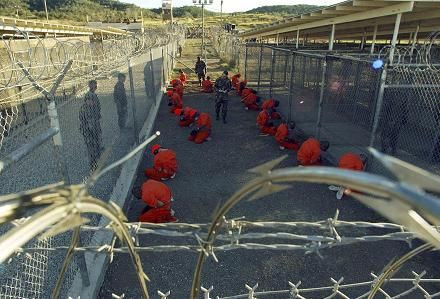CIA 'Black Sites': The Secret Prisons Where The US Held Its Terror Suspects

Cuba's Guantanamo Bay is the most well-known facility where the CIA committed ghastly acts of torture in recent years, but foreign terror suspects were also subjected to beatings, waterboarding and rectal feeding, among other brutal acts of violence, in secret sites across the globe. In some cases, the facilities in Cuba, Iraq, Lithuania, Thailand, Romania, Afghanistan and Poland are still in operation, more than six years after the Obama administration banned the enhanced interrogation tactics detailed in a lengthy report on the CIA's surveillance program released Tuesday.
Established in January 2002 within the Guantanamo Bay Naval Base in Guantanamo Bay, Cuba, "Gitmo" famously houses dozens of prisoners whom U.S. authorities cannot bring to the U.S. to stand trial due to congressional action and whom have also been deemed unsuited for extradition or release. President Barack Obama promised before he was elected to make closing the prison a top priority, but many detainees at Guantanamo have still not been charged and will never stand trial. Activists have tried for a decade to get the U.S. government to shut down Guantanamo Bay, citing prisoner abuses. A number of its inmates have gone on hunger strikes in protest, prompting medical staff there to institute force-feeding measures widely seen as unconstitutional.
The heavily redacted report released Tuesday detailed the treatment of nearly 100 suspects held by U.S. operatives between 2001 and 2009 on terrorism charges. Senate Intelligence Committee Chair Dianne Feinstein said the techniques used by the CIA were "far more brutal than people were led to believe" and that "coercive techniques regularly resulted in fabricated information" from detainees.
In Afghanistan, a "black site" that has emerged as the most brutal was “Detention Site Cobalt,” which was built outside Kabul for $200,000 in 2002, according to the Senate report. Described in the report as the "Salt Pit" and the CIA prison most like a "dungeon," it was dark inside 24 hours a day. Torture tactics employed by interrogators there hoping to "break" the site's prisoners included dousing suspects in water, leaving them in cold cells and blasting music to keep them up for days at a time. Forced rectal feedings also took place.
In Iraq, Abu Ghraib housed terror suspects between 2003 and 2006, which was graphically photographed and detailed by former prisoners and interrogators. Their accounts and images became the basis of an international scandal over the use of tactics including waterboarding, sodomizing with objects and forced nudity. The torture at Abu Ghraib led to court martials and charges against a number of U.S. soldiers, some of whom went to jail for crimes including aggravated assault, battery and maltreatment.
In Thailand, "Detention Site Green" is less well-known but was also used by the CIA to interrogate and hold prisoners in the early years of the first decade of the 21st century. The Senate report released Tuesday included few further details about the prison or any torture that may have taken place there. The only section of the report to address Thailand was almost entirely redacted, but it is known that the Thai government allowed the U.S. to set up a black site there.
In Romania, "Bright Light" housed terror suspects, including 9/11 mastermind Khalid Sheikh Mohammed, until it was shuttered in 2006. Located on a residential street in a nondescript office complex, Bright Light is unique in its position near heavily trafficked areas, according to an in-depth Associated Press investigation. "Harsh interrogation tactics" that took place in the facility's basement included sleep deprivation and stress positions.
Poland was home to the black site known as "Quartz." Former Polish President Aleksander Kwaśniewski acknowledged Wednesday that he knew the site existed but that he did not know torture tactics were being used on its prisoners, Reuters reported. Located in a remote forest near the village of Stare Kiejkuty in northeastern Poland, Quartz hosted prisoner abuses, the European Court of Human Rights has ruled, though few details have been made public. Poland asked the U.S. to sign a document saying the facility was treating its detainees humanely, and when the U.S. refused to sign it, Kwaśniewski requested it be shuttered, according to Reuters.
In Lithuania, the CIA operated a secret detention facility between 2004 and 2005 out of a former café in the forest town of Antaviliai, near the larger city of Vilnius, ABC News reported. The Baltic state allowed the CIA to build the prison within its borders after George W. Bush visited in 2002 and said he would support its bid to join NATO, according to ABC. The facility was used to torture up to eight suspects at once, using tactics like forced standing, stress positions and sleep deprivation, according to human rights advocacy groups.
Another site was built for at least $1 million, the Senate report showed, but "aborted" in 2006 due to the “absence of adequate emergency medical care options." It's unclear where the site was located.
The report states that the CIA gave foreign governments millions of dollars to “increase support” for its black sites, a practice that smoothed the way for its web of prisons to spread around the world.
© Copyright IBTimes 2024. All rights reserved.





















